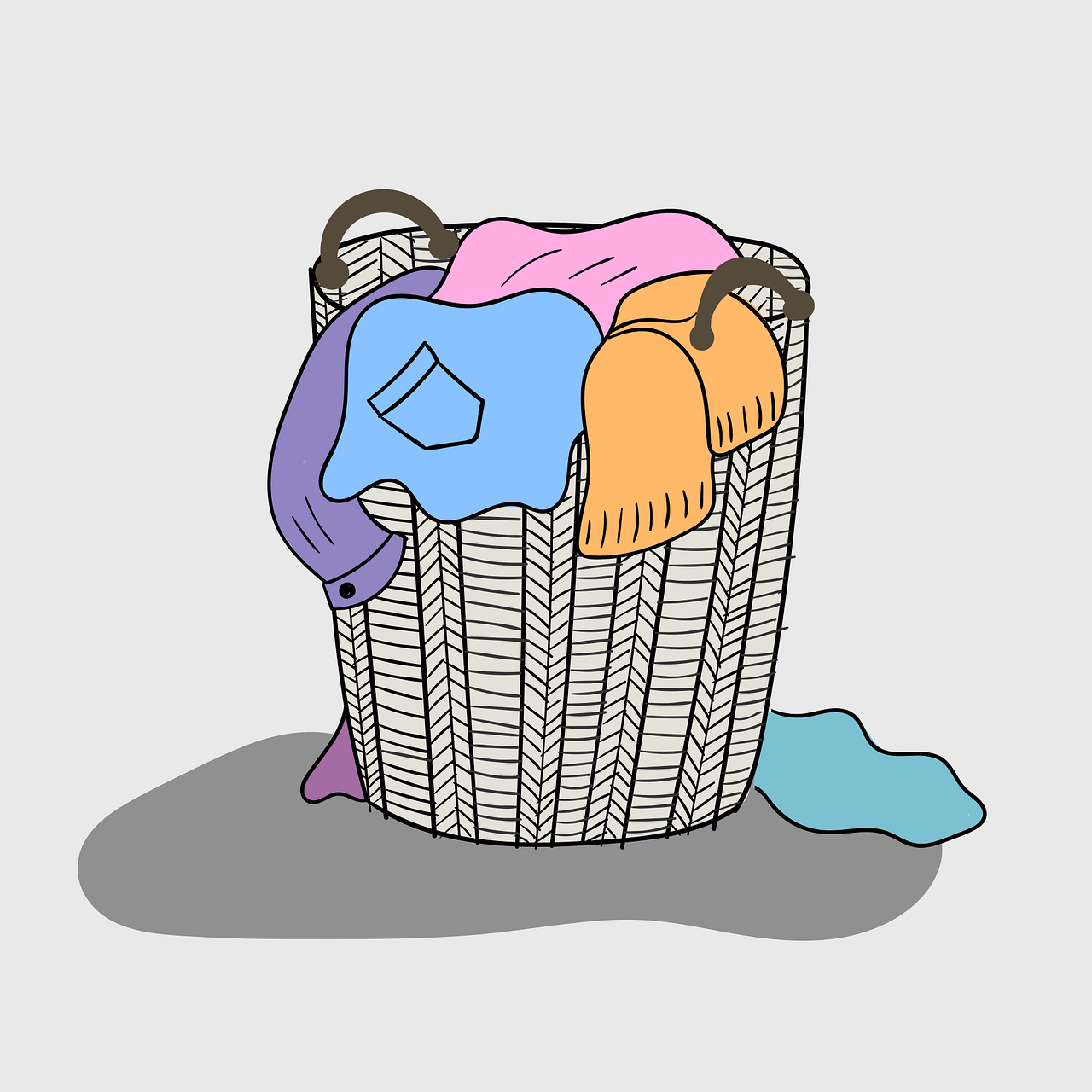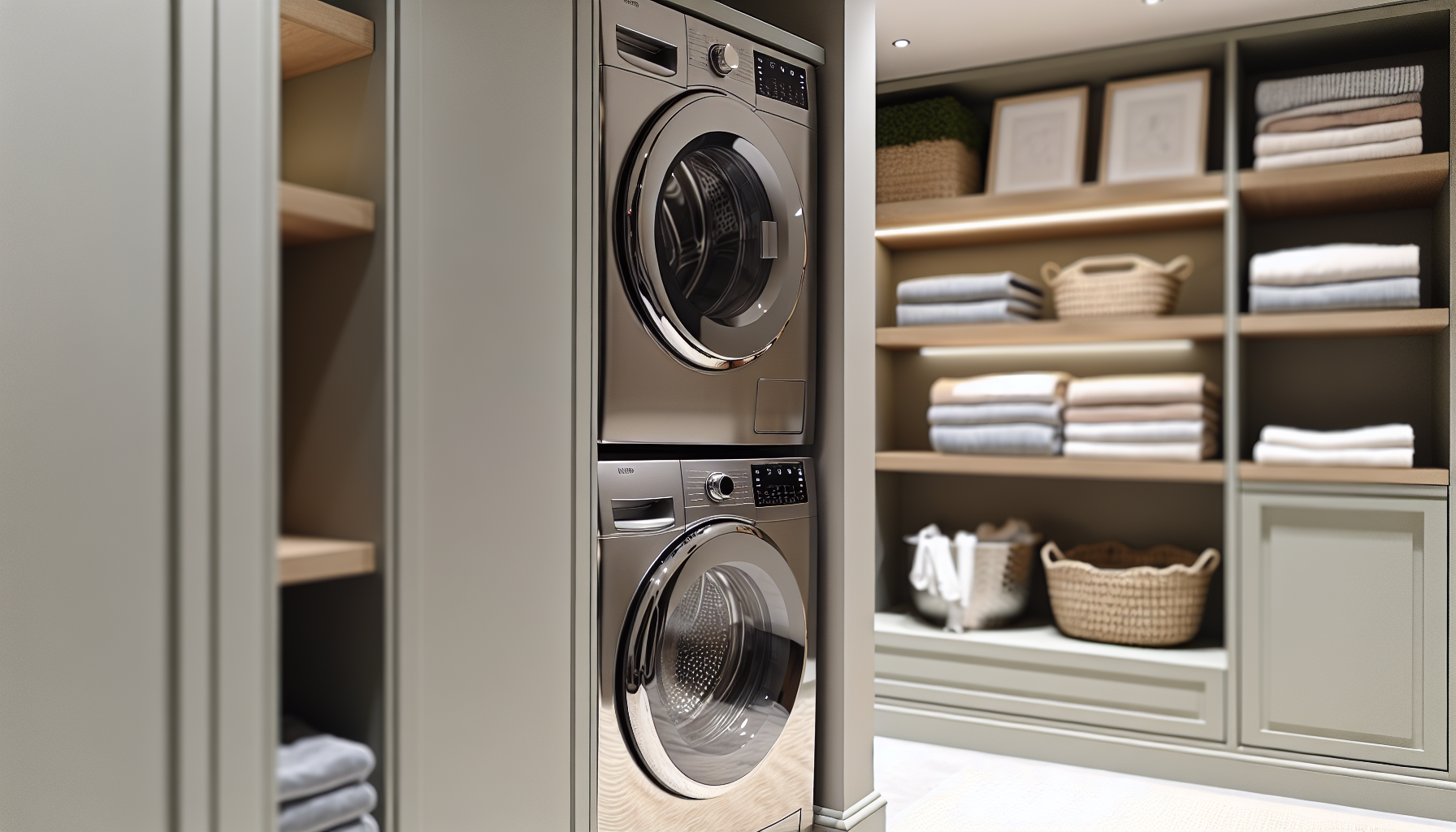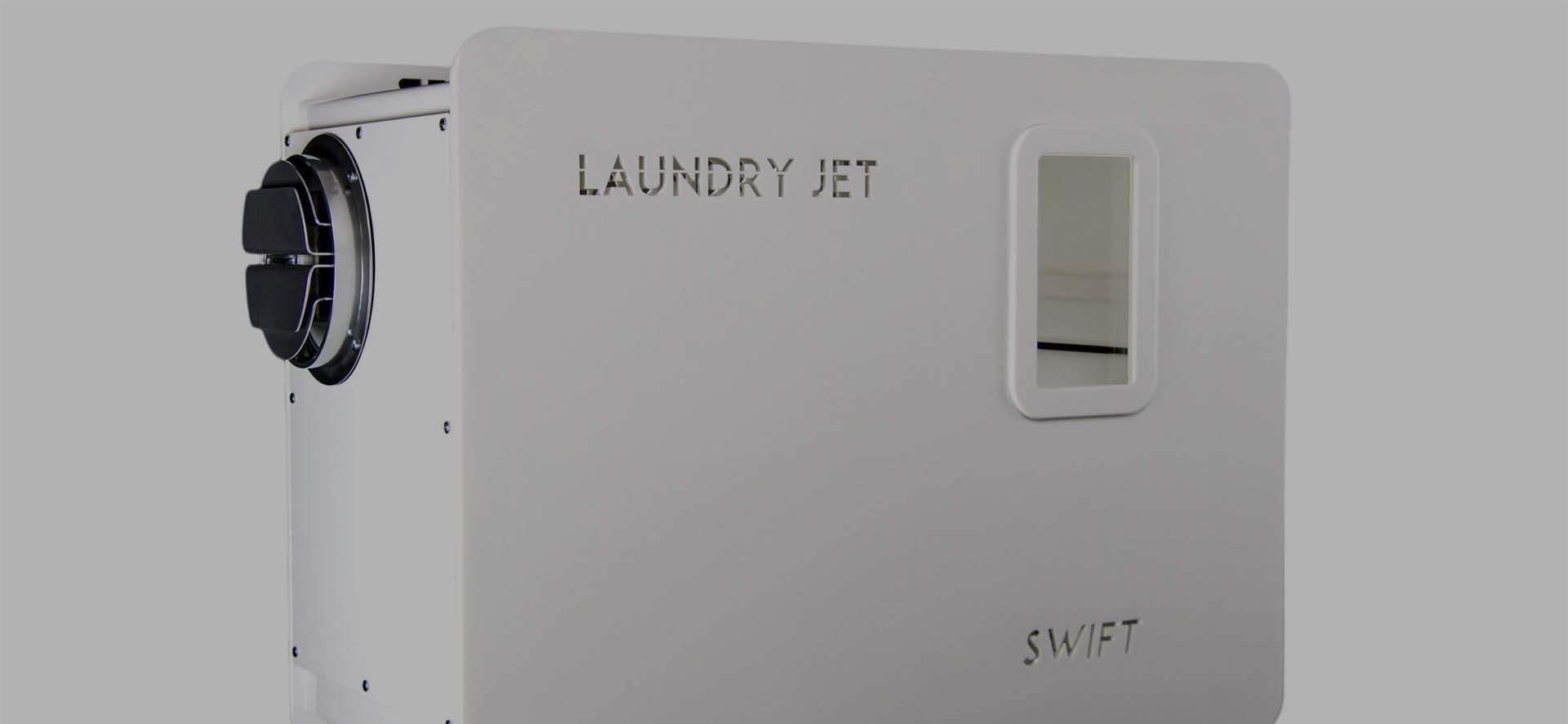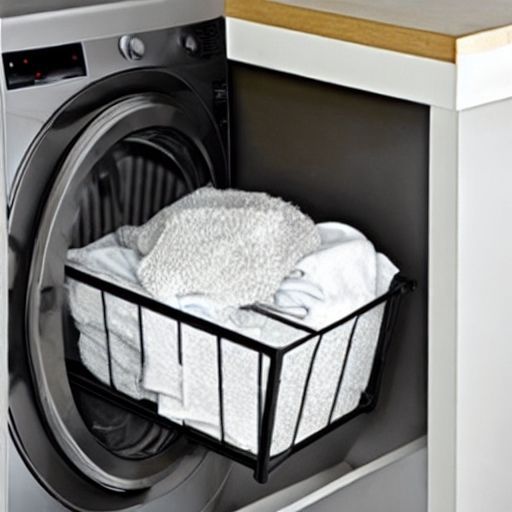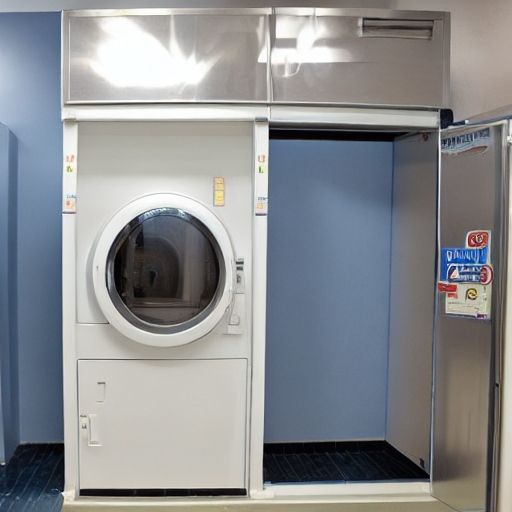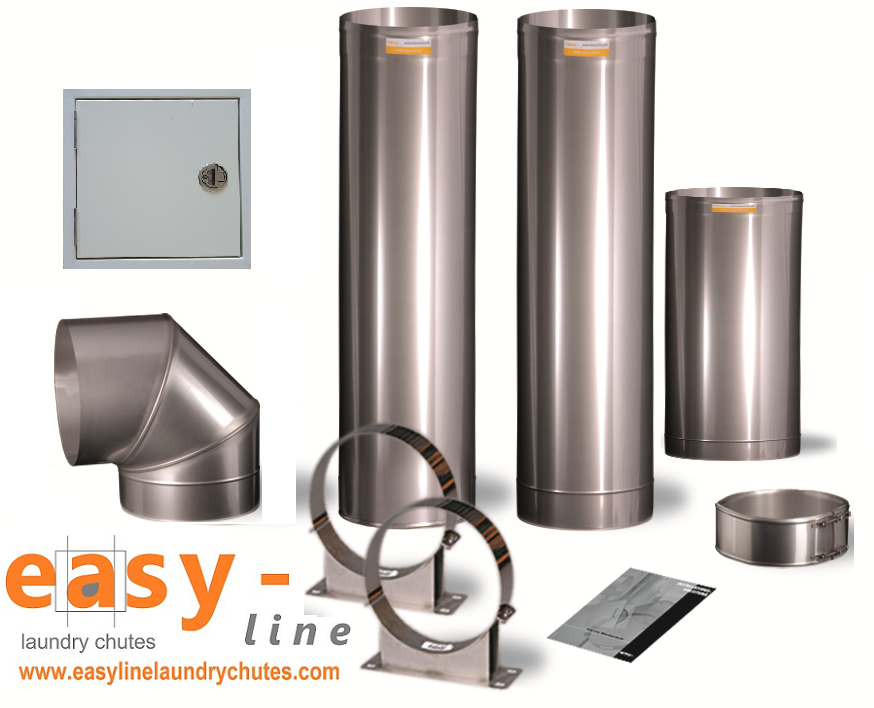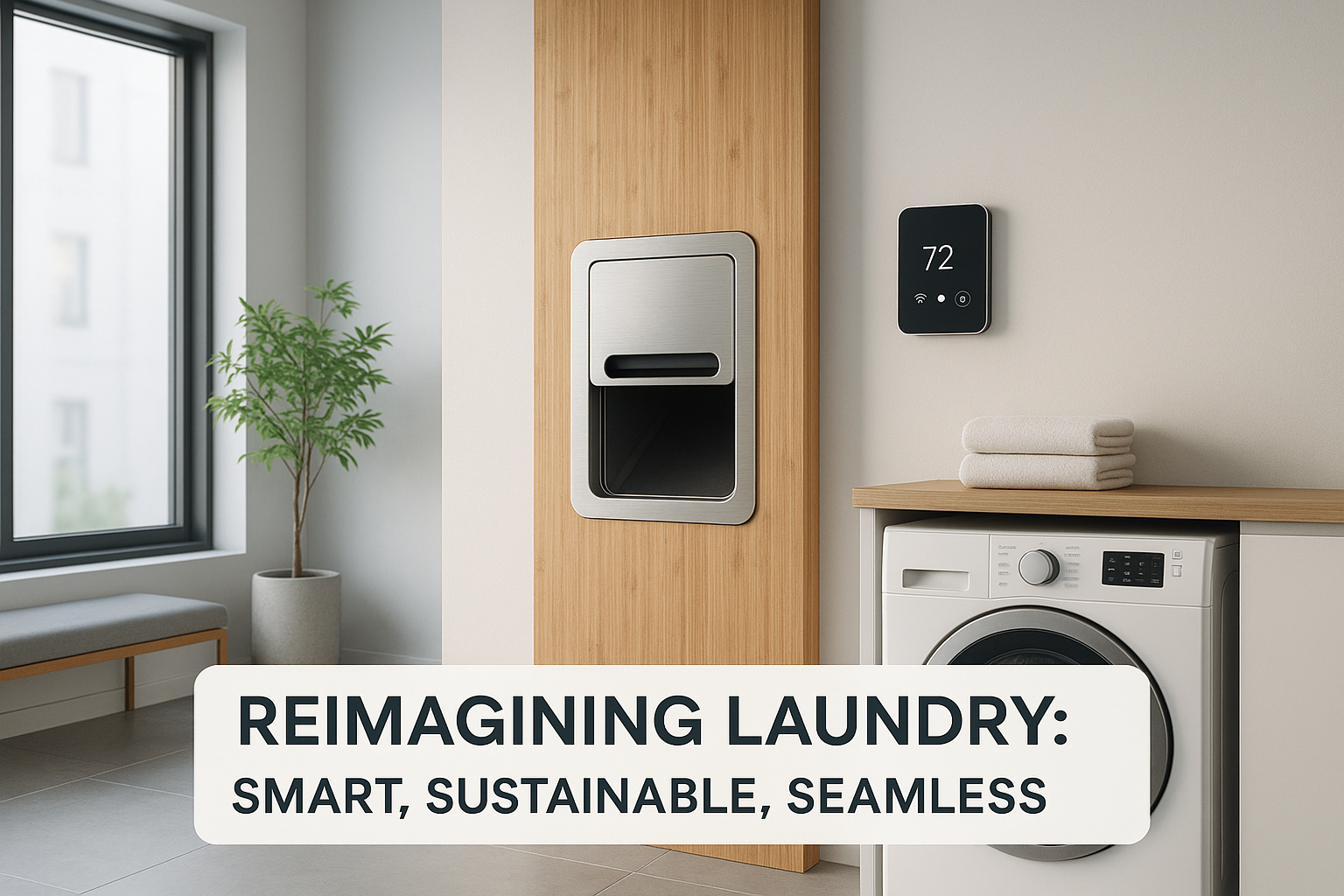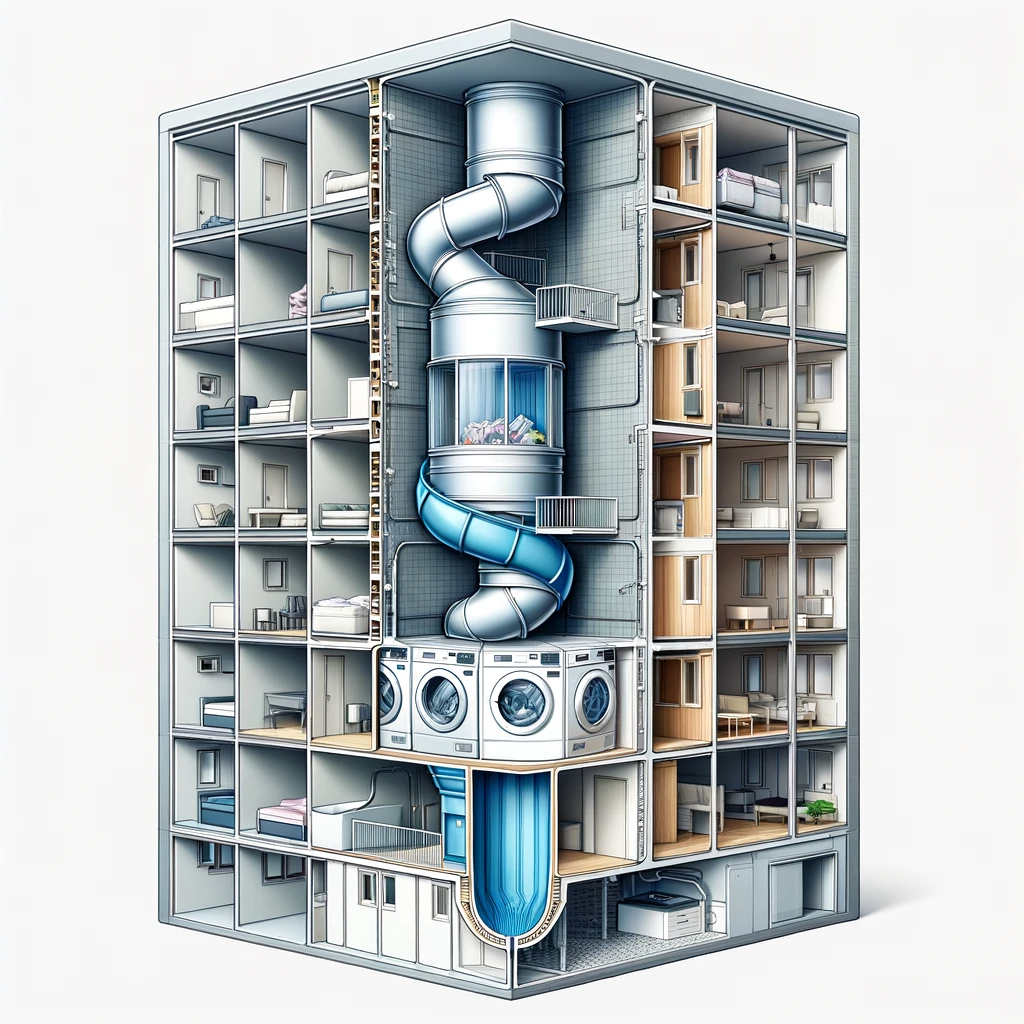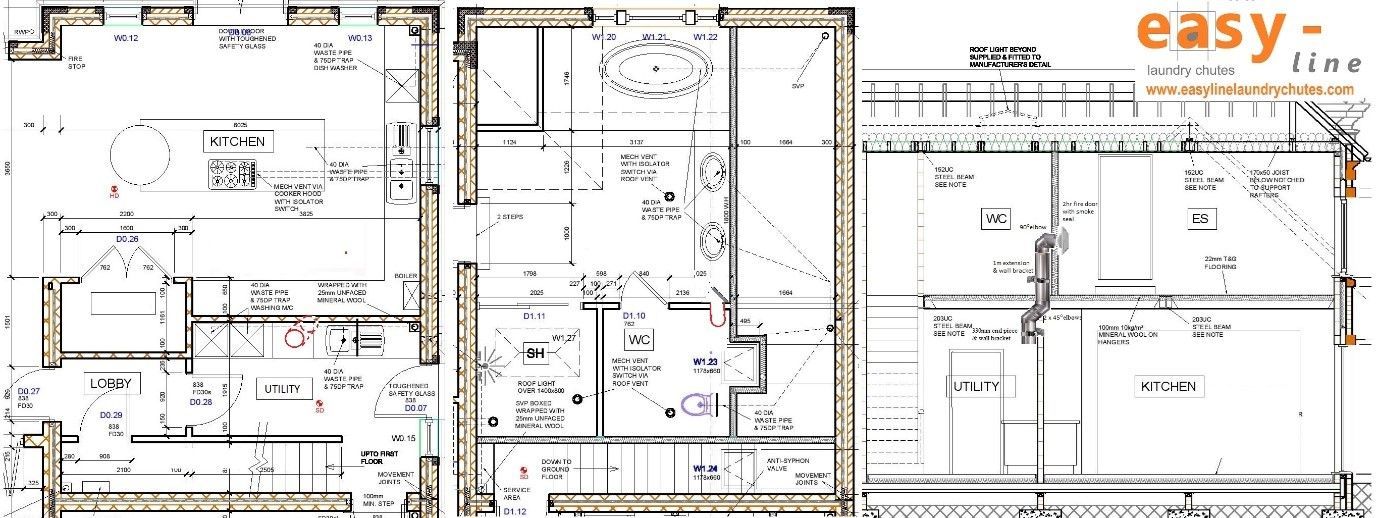Top 8 Laundry Chute Ideas (2024)
Maximise Your Space: Top Laundry Chute Ideas for a Streamlined Home
Are you tired of carrying heavy laundry hampers up and down the stairs? Imagine having a streamlined home with a laundry chute that makes laundry and your life so much easier. In this blog post, we’ll explore innovative laundry chute ideas, such as hidden chutes, decorative doors, and multipurpose chutes, as well as various location ideas for your laundry chute. Let us guide you on a journey to create a functional and attractive addition to your home.
Key Takeaways
- Maximise your home’s efficiency and aesthetic with innovative laundry chute designs, including hidden chutes, decorative doors and multipurpose chutes.
- Carefully plan the installation of a laundry chute in various locations such as upstairs bathrooms or bedroom closets.
- Ensure proper safety and maintenance by regularly inspecting the structure, installing locks/safety gates for childproofing, using cleaning techniques to maintain optimal performance.
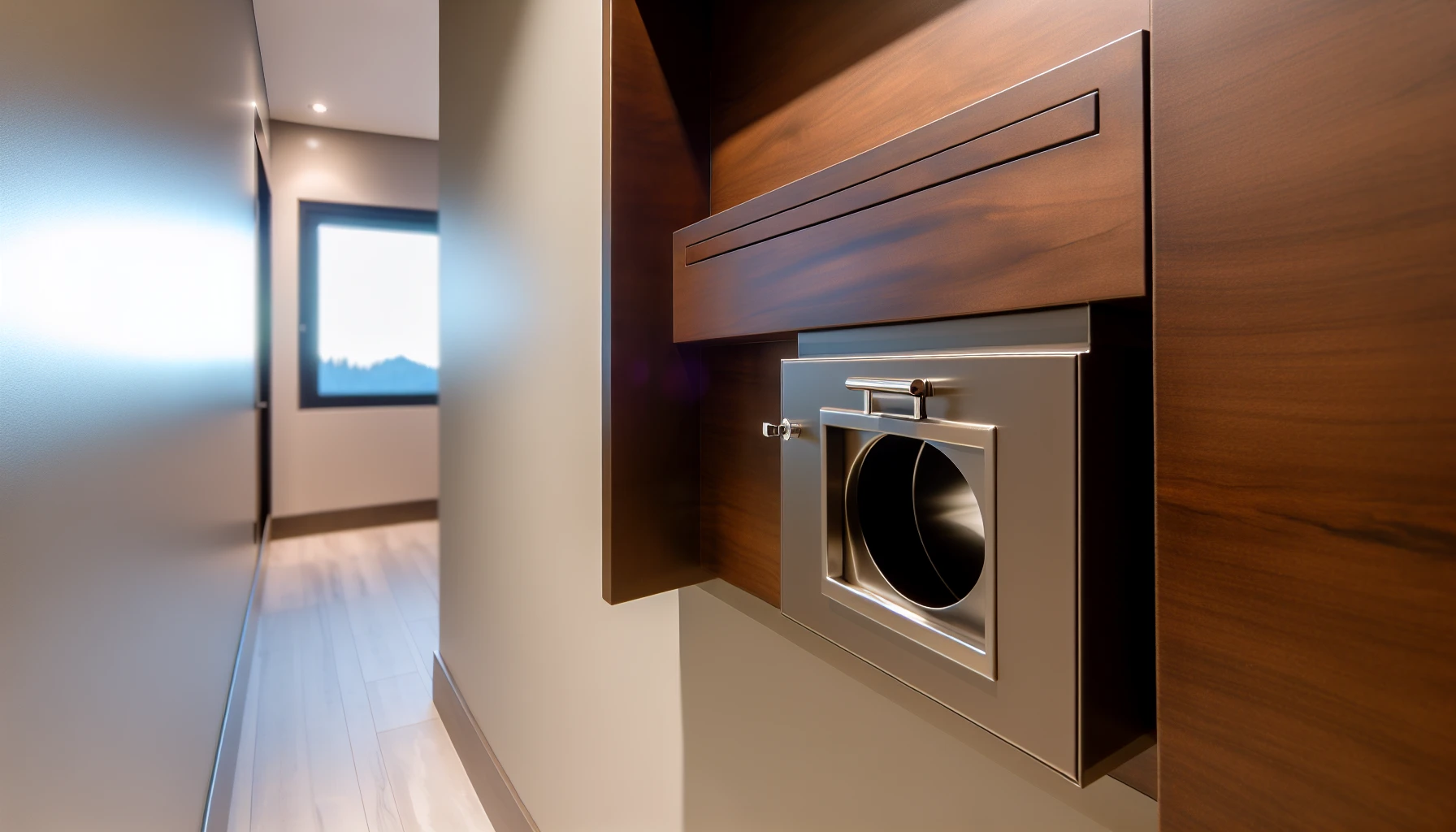
Innovative Laundry Chute Designs
Laundry chutes redefine efficiency in any home, streamlining laundry day by enabling easy transfer of dirty clothes from upper floors to the laundry room and eradicating the need for a laundry hamper on each level. Innovative laundry chute designs, such as hidden chutes, decorative doors, and multipurpose chutes, can enhance your home’s aesthetic and functionality. Consider installing a new laundry chute to further improve your laundry routine.
We will examine each of these designs in detail.
Hidden Chutes
Hidden chutes are engineered to blend flawlessly with your home’s decor, rendering them nearly undetectable. Some creative ideas for concealing laundry chutes include:
- Utilising a decorative hamper with a lid
- Incorporating the laundry chute into a closet
- Constructing the laundry chute into furniture
- Installing it behind a door or within a cabinet in an upstairs hall bathroom design
These ideas allow for easy access to the laundry chute within the laundry closet while keeping it discreet and blending it into the overall design of the master closet, including the integration of a wall cabinet.
Suitable materials for covering a dryer or hidden laundry chute include metal, melamine, plastic heating duct, sheeting, laminate, and stainless steel.

Decorative Doors
Decorative doors can infuse your laundry chute with style, transforming it into a design element. Examples of popular decorative door designs for laundry chutes include those featured on Houzz, showcasing various designs for basement laundry rooms and functional yet visually appealing laundry chute access doors.
Materials typically used for decorative laundry chute doors include:
- Wood
- Metal
- Glass
- Laminate
By providing visual interest and style to the overall design, a decorative door can contribute to the aesthetic appeal of a laundry chute, harmonising with the decoration of the surrounding laundry area, and creating a unified appearance.
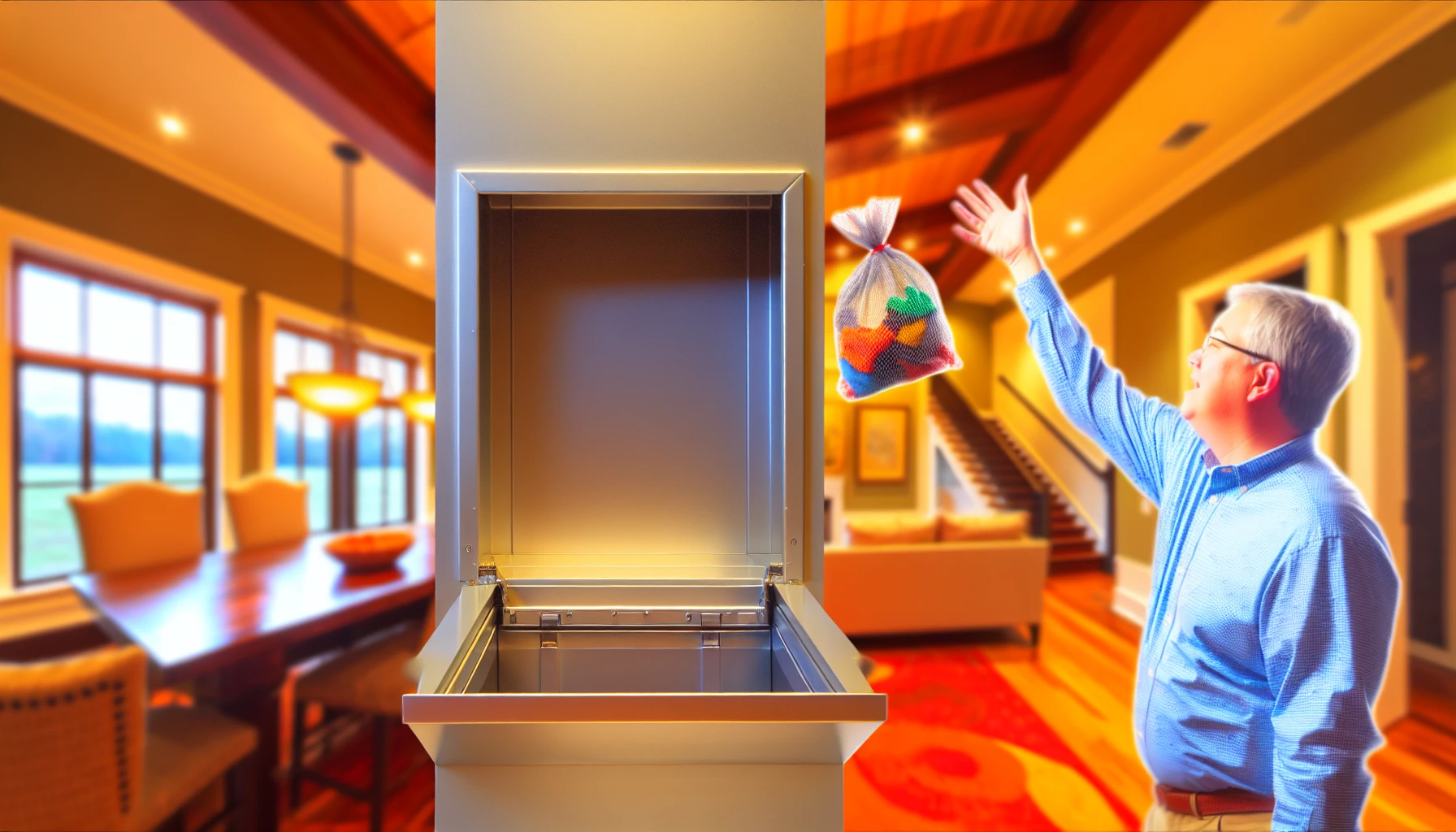
Multipurpose Chutes
Multipurpose chutes serve various domestic purposes, such as disposing of laundry, waste, or recycling. Design options for these chutes include:
- Vintage-inspired designs with a DIY touch
- Utility room designs for practicality and organisation
- Modern home designs
- Custom designs with built-in ironing boards, clothes rack drying systems, sinks, and folding stations
Multipurpose chutes offer households a convenient and efficient means of waste and laundry disposal, streamlining the home by eliminating the need for multiple bins or hampers in different rooms, and improving safety and cleanliness by containing odors and mess.
Suitable materials for multipurpose chute construction include polythene sheeting and tubing, strong and weather-resistant materials, abrasion-resistant materials, and rigid materials.
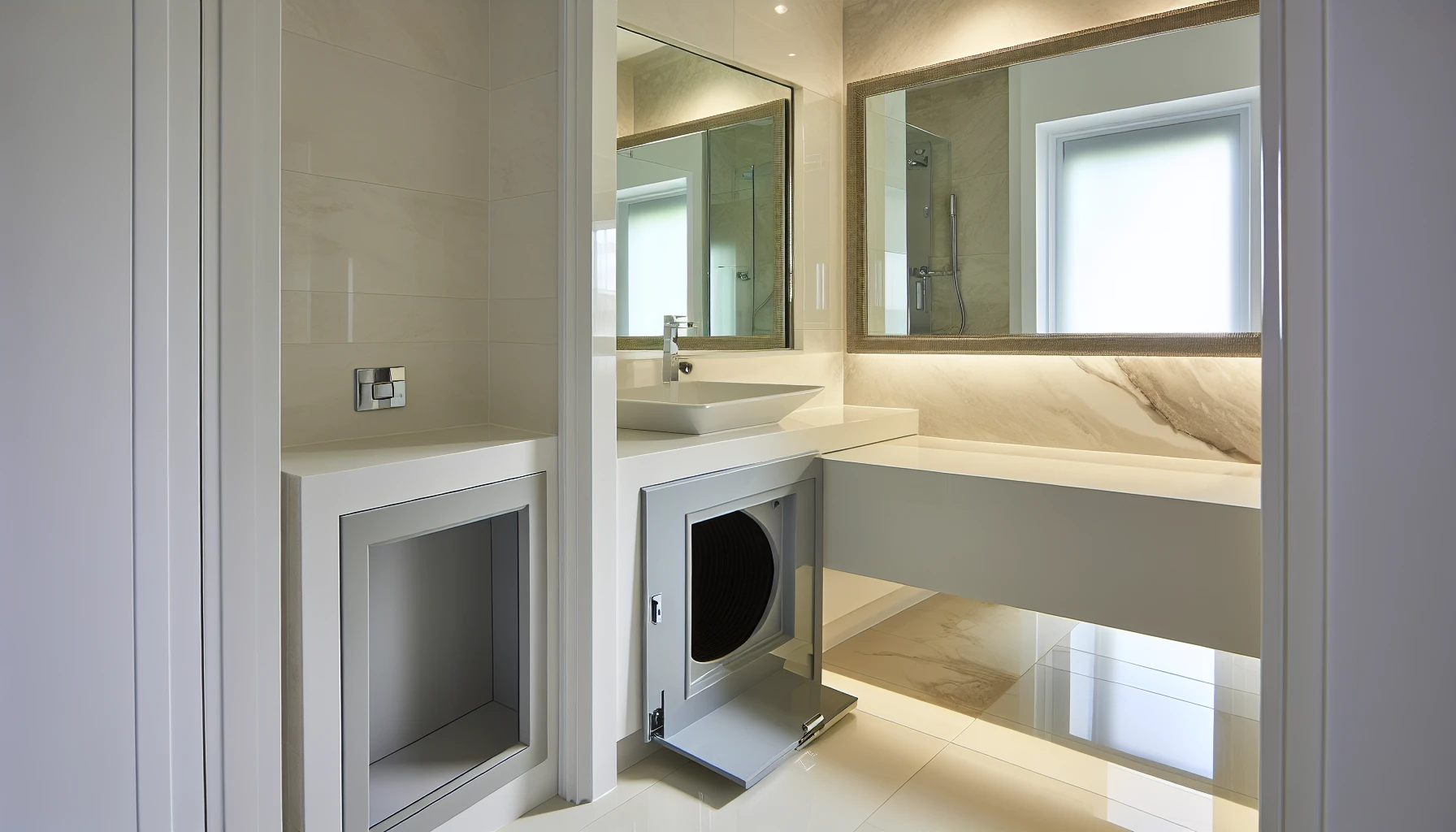
Location Ideas for Your Laundry Chute
The location of your laundry chute plays a significant role in its functionality and convenience. Depending on your home’s layout and needs, potential locations include upstairs bathrooms, bedroom closets, and hallways or main floors. Additionally, a basement laundry room can be a suitable option for installing a laundry chute.
We will examine the advantages and installation factors for each of these locations.
Upstairs Bathroom
Incorporating a laundry chute in an upstairs bathroom is an excellent way to maintain the cleanliness of the space by keeping dirty laundry out of sight. When installing a laundry chute in an upstairs bathroom, it is advised to select the most suitable location, such as the master bath or main hallway, for easy access from other bedrooms downstairs.
Ingenious design ideas for an upstairs bathroom laundry chute might include:
- Adopting a vintage-inspired design
- Positioning a chute between the studs
- Attaching a door to the chute
- Linking it to the basement laundry for enhanced convenience
Metal ductwork and stainless steel are the most suitable materials for constructing a laundry chute in an upstairs bathroom due to their smooth surfaces and long-term durability.
Bedroom Closet
Having a laundry chute in a bedroom closet provides a convenient and discreet means of disposing of dirty clothes. One potential approach is to cut a hole in an opening in the closet ceiling and affix the chute using sheet metal screws. Alternatively, a reciprocating saw could be employed to cut the opening and then install any necessary fire-blocking.
Creative design ideas for a laundry chute in a bedroom closet include creating a laundry chute using PVC pipes, which allows for easy installation, storage and customisation. The typical space requirement for a laundry chute in a bedroom closet is 12 in. by 12 in..
Hallway or Main Floor
For homes with limited space or unique layouts, hallways or second floor can be ideal for laundry chutes. Innovative designs for hallway or main floor laundry chutes include options such as openings on the top floor in the hallway for convenient access from the bedrooms and creative utility room concepts incorporating laundry chutes and drawers for an efficient and organized space.
To seamlessly incorporate a laundry chute or sink into a hallway or main floor layout, follow these steps:
- Begin with a vertical door on a wall in the hallway for easy access.
- Install the chute in an interior wall that runs parallel to the floor joists.
- Place the chute inside a 90° elbow around 1m from the floor.
- Drop the chute down to the washing area below.
DIY Laundry Chute Installation
If you’re up for a DIY challenge, installing a laundry chute can be a rewarding project. With proper planning and measuring, cutting and framing, and adding finishing touches, you can create a functional and attractive laundry chute in your home.
We will elaborate on each of these steps further.
Planning and Measuring
Planning and measuring guarantee that your laundry chute fits accurately and aligns with your home’s structure. To ensure precise measurement of a laundry chute installation, you will need the following tools:
- Tape measure
- Bubble level
- Pencil
- Reciprocating saw (possibly)
Proper planning and measuring are essential to guarantee the laundry chute is accurately fitted and in line with the home’s structure, ensuring easy access to the laundry room and reducing clutter on both floors.
Cutting and Framing
Cutting and framing involve creating openings for the chute and building a sturdy frame to support it. A 4-in-1 screwdriver, drill bit set, cordless drill/driver, drywall saw, reciprocating saw, and tape measure are recommended for cutting and framing a laundry chute. When cutting and framing a laundry chute, it is important to consider various safety measures, such as ensuring the interior is smooth to avoid items getting stuck or causing harm and selecting an appropriate location for the chute that does not obstruct any framework or home fixtures.
Metal ductwork, melamine, and plastic heating duct are all suitable materials for constructing the frame of a laundry chute house, while a metal chute can be an alternative option for the actual passage.
Finishing Touches
Finishing touches, such as trim and paint, complete the look of your laundry chute and ensure it blends with your home’s design. To install trim on a laundry chute door, trim and fold over the opening flap that you cut, then install the chute using sheet metal screws, attaching the duct to the top blocking and the chute to small door opening.
We recommend using clear polyurethane in either a gloss or satin finish for the best results on a laundry chute. By taking these steps, you can effectively create a functional and attractive addition to your home.
Retrofitting a Laundry Chute in Older Homes
Retrofitting a laundry chute in older homes requires identifying suitable locations, adapting to unique architectural features, and preserving the home’s aesthetic.
We will delve deeper into how to accomplish these objectives.
Identifying Suitable Locations
Identifying suitable trash chute locations involves finding spaces that align with your home’s structure and provide easy access to the laundry room. To determine suitable locations for a laundry chute in older homes, consider accessibility, structural considerations, plumbing and ventilation, fire safety, noise and privacy, and space availability.
By taking these factors into account, you can ensure the laundry chute is suitably incorporated into your home’s existing structure and offers convenient access to the laundry room.
Adapting to Unique Architectural Features
Adapting to unique architectural features in older homes may require creative solutions, such as using flexible ductwork or custom-built chutes. Flexible ductwork is a ductwork type composed of flexible materials, such as plastic or metalized polyester film, and can be bent and adjusted to suit the specific layout and design of the laundry chute, making it an advantageous option for installation.
Custom-building a laundry chute to accommodate unique architectural features can involve determining the location, planning the chute design, measuring and cutting an opening, installing the chute, and testing and making adjustments.
Preserving the Home's Aesthetic
Maintaining the home’s visual appeal while retrofitting a laundry chute requires selecting materials and designs that harmonize with the existing style and architecture. To ensure a cohesive and timeless appearance, select materials and finishes that match the existing decor and ensure that the remodel laundry chute is correctly installed and sealed to avert any water damage or leaks.
By taking these measures, you can successfully retrofit a laundry chute in your older home while maintaining its classic charm.
Laundry Chute Safety and Maintenance
Regular safety and maintenance tasks are key to keeping your laundry chute functioning efficiently and safely. We will discuss how to prevent clogs and damage, make your laundry chute safe for children, and apply effective cleaning techniques in the subsequent sections.
Preventing Clogs and Damage
To prevent clogs and damage, you should regularly check your laundry chute for blockages and ensure it’s appropriately supported. Frequent causes of laundry chute blockages include overloading the chute, clothes becoming snagged in the chute walls, and a buildup of lint, soap residue, and limescale in the chute.
To avoid clogs and damage, inspect your laundry chute every few months to ensure it’s functioning properly. Proper support and maintenance for your laundry chute includes:
- Installing fire-rated doors
- Using access panels for cleaning and maintenance
- Ensuring proper installation to avoid disruption of plumbing and electric wiring
These measures are crucial for keeping your washing machine and laundry chute in top condition.
Childproofing Your Laundry Chute
To make your laundry chute safe for children, you may consider:
- Installing locks or safety gates to avert mishaps
- Recommended locks for laundry chute doors include the swivel hinge lock and latch lock, which can be sourced from various online retailers
- To properly install a safety gate on a laundry chute, measure the width of the opening, select an appropriate gate, install it according to the manufacturer’s instructions, and ensure it is securely attached.
By taking these steps, you can effectively childproof your laundry chute and prevent accidents.
Proper Cleaning Techniques
Effective cleaning methods, like vacuuming and wiping down surfaces, aid in preserving the functionality and appearance of your laundry chute. To clean a laundry chute, use a long tool such as a yardstick or broom handle with a straightened metal coat hanger attached to dislodge any obstructions. Additionally, wiping down the inside with a cloth or sponge can be beneficial.
By regularly cleaning and maintaining your laundry chute, you can ensure its longevity and optimal performance.
Summary
In conclusion, a well-designed and properly installed laundry chute can greatly improve your home’s functionality and convenience. By exploring innovative designs, finding the perfect location, and maintaining your laundry chute, you can streamline your home and make laundry day a breeze. So, why not transform your laundry routine and add a touch of style to your home with a custom laundry chute?
Frequently Asked Questions
Why don t they make laundry chutes anymore?
Laundry chutes have been eliminated from modern homes due to safety concerns around allowing fires to spread quickly between levels. Multi-level homes now feature laundry rooms installed on the same floor as bedrooms, providing a much safer and more convenient alternative.
What can I use for a laundry chute?
For a laundry chute, metal ductwork is recommended due to its smooth and quick installation. It can also be angled and formed to avoid obstacles.
Is a laundry chute a good idea?
Installing a laundry chute is worth considering for its convenience and ability to keep odours away - it will save time and increase ease in your home.
How do I choose the best location for a laundry chute in my home?
When selecting the best location for a laundry chute in your home, be sure to take into account accessibility, structure, plumbing and ventilation, and space availability. Popular locations include bathrooms, closets cabinets, hallways, and main floors.
What materials are recommended for constructing a laundry chute?
For constructing a laundry chute, metal ductwork and stainless steel are recommended due to their durability and smooth surfaces.
